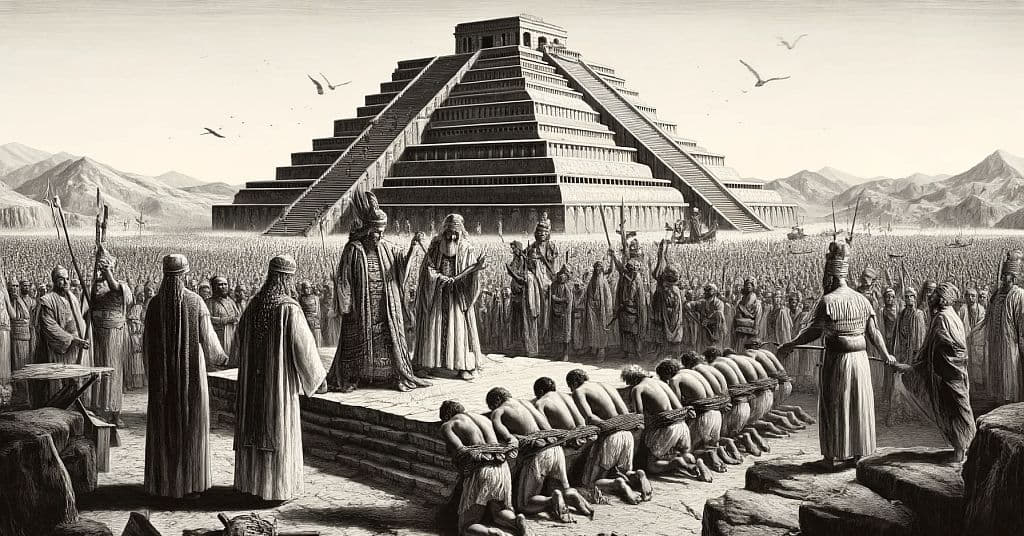 Several ancient cultures practiced mass sacrifice for a variety of reasons.
Several ancient cultures practiced mass sacrifice for a variety of reasons.
Mass Human Sacrifice #
What ancient cultures practiced mass sacrifice and was there a practical incentive to do so, like the exhaustion of resources? #
Several ancient cultures practiced mass sacrifice for a variety of reasons, often tied to religious, political, or social beliefs rather than direct practical incentives like the exhaustion of resources. Some of the cultures known for such practices include:
The Aztecs #
The Aztecs are perhaps the most well-known for their practice of human sacrifice. They believed that such sacrifices were necessary to appease the gods and ensure the continuation of the world. For instance, the sun god Huitzilopochtli required human blood to rise each day. The Aztecs conducted these sacrifices during large public ceremonies that also served political and social purposes, such as solidifying the power of the ruling class and intimidating enemies.
The Maya #
The Maya civilization is known to have practiced human sacrifice as well, although on a smaller scale than the Aztecs. The reasons were also primarily religious, as sacrifices were made to please the gods, particularly in times of distress such as droughts or famines. The famous “cenotes” (natural wells) in places like Chichen Itza were believed to be gateways to the underworld and were often sites of such sacrifices.
The Moche #
The Moche culture of ancient Peru is another example where human sacrifice was a ritual practice. They conducted sacrifices during certain religious ceremonies and might have believed that these sacrifices helped maintain agricultural fertility and social hierarchy.
Ancient China #
Human sacrifice was practiced in various dynasties of ancient China, such as the Shang Dynasty. These sacrifices were often related to burial practices, where servants or captives might be sacrificed to accompany the deceased ruler in the afterlife.
The Celts #
There is historical and archaeological evidence suggesting that some Celtic tribes practiced human sacrifice. The Greek historian Strabo, for example, wrote about the Gauls’ practice of human sacrifice. However, much of what is known is based on accounts from other cultures, such as the Romans, which may be biased.
Carthage #
In Carthage, child sacrifice to the gods, particularly to Baal Hammon and Tanit, was reported by ancient authors and has been supported by archaeological evidence. However, there is still debate among historians and archaeologists about the extent and nature of these sacrifices.
While the practice of mass sacrifice did not necessarily have direct practical incentives, it could indirectly affect a society’s resource management. For instance, the spectacle of sacrifice could consolidate power in the hands of a ruling elite, which could then implement policies for resource management. Fear of divine retribution, as interpreted by priestly classes, might also lead to changes in social behavior that could include more prudent use of resources. However, the primary incentives behind mass sacrifices were typically theological and sociopolitical rather than practical in the economic or ecological sense.
Mesopotamia? #
In ancient Mesopotamia, mass sacrifice was not as prominently practiced or recorded as in some other ancient cultures, such as the Aztecs or the Maya. However, there are still notable instances and practices related to human sacrifice, though they were less frequent and more symbolic in nature.
Foundation Sacrifices #
There is evidence that human sacrifices were sometimes performed as foundation rituals for building projects. These sacrifices were believed to consecrate and protect the structure. For example, skeletons have been found buried under the foundations of buildings, which some scholars interpret as evidence of such practices.
Royal Burials #
In Ur, during the Early Dynastic period, several royal graves have been excavated that included the remains of servants and guards who were likely sacrificed to accompany the deceased king or queen into the afterlife. The famous Royal Cemetery of Ur, excavated by Leonard Woolley, uncovered graves that contained the bodies of attendants who were buried with the royal individuals, suggesting they may have been ritually killed to serve in the afterlife.
Mythological References #
Mesopotamian mythology includes references to human sacrifice. For example, in the myth of the god Enlil and Ninlil, Enlil is punished and part of the penance involves symbolic acts that hint at sacrificial elements.
Despite these instances, the practice of human sacrifice in Mesopotamia was not as systemic or widespread as in some other cultures. The primary religious practices in Mesopotamia revolved around offerings of animals, food, drink, and other goods to the gods rather than human lives.
Practical Incentives #
Religious Belief: Like in other cultures, sacrifices were made to appease deities and ensure their favor. This could be interpreted as a way to ensure good harvests, success in battle, and general prosperity.
Social and Political Control: Human sacrifices, especially in the context of royal burials, would reinforce the social hierarchy and the divine right of kings. It would also demonstrate the power of the ruling class and their closeness to the gods.
Consecration and Protection: Foundation sacrifices were intended to protect buildings and cities, ensuring stability and safety for the inhabitants.
In summary, while human sacrifice was present in ancient Mesopotamia, it was not as central to their religious or cultural practices as it was in some other ancient civilizations. The instances that did occur were more symbolic and tied to specific rituals rather than widespread or frequent practices driven by practical incentives like resource management.